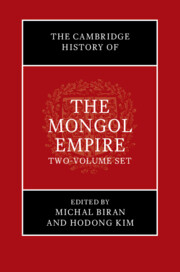Book contents
- The Cambridge History of the Mongol Empire
- The Cambridge History of the Mongol Empire
- Copyright page
- Dedication
- Contents
- Figures in Volume I
- Figures in Volume II
- Maps in Volume I
- Maps in Volume II
- Tables in Volume I
- Contributors to Volume I
- Contributors to Volume II
- Acknowledgments
- Notes on Dates and Transliterations
- Abbreviations
- Volume I
- Volume II
- Volume II Part 1 Literary Sources
- 1 Persian Sources
- 2 Chinese Sources
- 3 Mongolian Sources
- 4 Arabic Sources
- 5 Rus′ian-Language Sources
- 6 Western European Sources
- 7 Armenian Sources
- 8 Georgian Sources
- 9 Turkic and Chaghatay Sources
- 10 Tibetan Sources
- 11 Korean Sources
- 12 Syriac Sources
- 13 Uighur Sources
- 14 Greek Sources
- 15 Tangut Sources
- 16 Hebrew Sources
- Volume II Part 2 Archaeological and Visual Sources
- Index to Volume I
- Index to Volume II
- References
3 - Mongolian Sources
from Volume II Part 1 - Literary Sources
Published online by Cambridge University Press: 01 January 2024
- The Cambridge History of the Mongol Empire
- The Cambridge History of the Mongol Empire
- Copyright page
- Dedication
- Contents
- Figures in Volume I
- Figures in Volume II
- Maps in Volume I
- Maps in Volume II
- Tables in Volume I
- Contributors to Volume I
- Contributors to Volume II
- Acknowledgments
- Notes on Dates and Transliterations
- Abbreviations
- Volume I
- Volume II
- Volume II Part 1 Literary Sources
- 1 Persian Sources
- 2 Chinese Sources
- 3 Mongolian Sources
- 4 Arabic Sources
- 5 Rus′ian-Language Sources
- 6 Western European Sources
- 7 Armenian Sources
- 8 Georgian Sources
- 9 Turkic and Chaghatay Sources
- 10 Tibetan Sources
- 11 Korean Sources
- 12 Syriac Sources
- 13 Uighur Sources
- 14 Greek Sources
- 15 Tangut Sources
- 16 Hebrew Sources
- Volume II Part 2 Archaeological and Visual Sources
- Index to Volume I
- Index to Volume II
- References
Summary
This chapter is an overview of the extant Middle Mongolian historical sources of the Mongol Empire, its documents arranged here according to their places of origin, the writing systems used, and their content and genres. They are described and evaluated in the following sections: extant and lost chronicles, Uighur script epigraphic monuments (edicts, epitaphs and other memorial inscriptions, graffiti, seal and coin inscriptions), Uighur script letters of Mongol rulers to foreigners, monuments from Qara-Qoto, Uighur script documents from the lands of the Ilkhans and their vassals and from the Turfan area and the Dunhuang Mogao caves, square-script monuments, and badges and xylograph fragments in square script or in Uighur letters. The notes also offer new interpretations of some passages of the monuments discussed.
- Type
- Chapter
- Information
- The Cambridge History of the Mongol Empire , pp. 972 - 1006Publisher: Cambridge University PressPrint publication year: 2023

